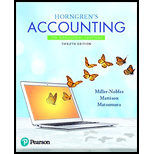
Concept explainers
T-Account: A T-account is a graphical representation of a general ledger account. The left-side of T-account shows the debit entries and the right-side of T-account shows the credit entries. Therefore, the journal
Closing Balance in a T-account shows the difference between the credit and debit balances. It is the closing balance of the account and is taken to the
Trial Balance: Trial Balance is a statement which contains all the closing debit and credit balances of ledger accounts and is prepared at the end of an accounting period. In Trial Balance, the total of debit balance is equal to the total of credit balance.
Journal entries are based on three following golden rules of accounting:
(i) ‘Debit the receiver and credit the giver’ – This is used in case of personal accounts. Personal accounts include persons (natural or legal) with whom the business does dealings. When a person receives anything from the business, he is called the receiver and his account is debited in the books of accounts. When a person gives anything to business, he is called the giver and his account is debited in the books of accounts. The giver’s accounts are mostly represented as payable accounts in the books of accounts. The receiver’s accounts are represented as receivable accounts in the books of accounts. Also, the prepaid accounts and accrued accounts are represented as personal accounts because they are indirectly linked to the person.
(ii) ‘Debit what comes in and credit what goes out’ - This is used in case of real accounts. Real accounts include tangible and intangible goods or property like cash, machinery, land and building etc. which either comes into the business or goes out of the business. When it comes into the business, it is debited in the books of accounts. When it goes out of the business, it is credited in the books of accounts.
(iii) ‘Debit all expenses and losses and credit all incomes and gains’ – This is used in case of nominal accounts. Nominal accounts include entity’s expenses, loss, income and gains. When a business earns income and gains, the account of that income is credited in the books of accounts. When a business incurs expenses or suffers loss, the account of that expense or loss is debited in the books of accounts.
1.
To Journalize: Each given transaction.
2.
To Post: The journal entries to the T-accounts, using transaction dates as posting references in the ledger accounts.
3.
To Prepare: The trial balance of Victor Yang, M.D., as of March 31, 2018.
Want to see the full answer?
Check out a sample textbook solution
Chapter 2 Solutions
Horngren's Accounting (12th Edition)
- Fixed overhead:55, Variable overhead:25arrow_forwardHello tutor solve this question and general accounting questionarrow_forwardEagles Manufacturing uses the declining balance method of depreciation. They purchased a machine for $160,000 with an estimated salvage value of $20,000 and a useful life of 5 years. Using a declining balance rate of 30%, calculate the depreciation expense for the second year of the machine's use.arrow_forward
- Vincent Company's cost of goods sold is $640,000 variable and $510,000 fixed. The company's selling and administrative expenses are $420,000 variable and $630,000 fixed. If the company's sales is $2,350,000, what is its net income/loss?arrow_forwardDakota Manufacturing uses a standard cost system in which manufacturing overhead is applied to units of product on the basis of standard machine hours. During April, the company used a denominator activity of 40,000 machine hours in computing its predetermined overhead rate. However, 52,000 standard machine hours were allowed for the month's actual production. If the fixed manufacturing overhead volume variance for April was $9,000 unfavorable, then the total budgeted fixed manufacturing overhead cost for the month was $_.arrow_forwardWhitney manufacturing produces die-cast metal tsve cars for toy shops.arrow_forward

 AccountingAccountingISBN:9781337272094Author:WARREN, Carl S., Reeve, James M., Duchac, Jonathan E.Publisher:Cengage Learning,
AccountingAccountingISBN:9781337272094Author:WARREN, Carl S., Reeve, James M., Duchac, Jonathan E.Publisher:Cengage Learning, Accounting Information SystemsAccountingISBN:9781337619202Author:Hall, James A.Publisher:Cengage Learning,
Accounting Information SystemsAccountingISBN:9781337619202Author:Hall, James A.Publisher:Cengage Learning, Horngren's Cost Accounting: A Managerial Emphasis...AccountingISBN:9780134475585Author:Srikant M. Datar, Madhav V. RajanPublisher:PEARSON
Horngren's Cost Accounting: A Managerial Emphasis...AccountingISBN:9780134475585Author:Srikant M. Datar, Madhav V. RajanPublisher:PEARSON Intermediate AccountingAccountingISBN:9781259722660Author:J. David Spiceland, Mark W. Nelson, Wayne M ThomasPublisher:McGraw-Hill Education
Intermediate AccountingAccountingISBN:9781259722660Author:J. David Spiceland, Mark W. Nelson, Wayne M ThomasPublisher:McGraw-Hill Education Financial and Managerial AccountingAccountingISBN:9781259726705Author:John J Wild, Ken W. Shaw, Barbara Chiappetta Fundamental Accounting PrinciplesPublisher:McGraw-Hill Education
Financial and Managerial AccountingAccountingISBN:9781259726705Author:John J Wild, Ken W. Shaw, Barbara Chiappetta Fundamental Accounting PrinciplesPublisher:McGraw-Hill Education





